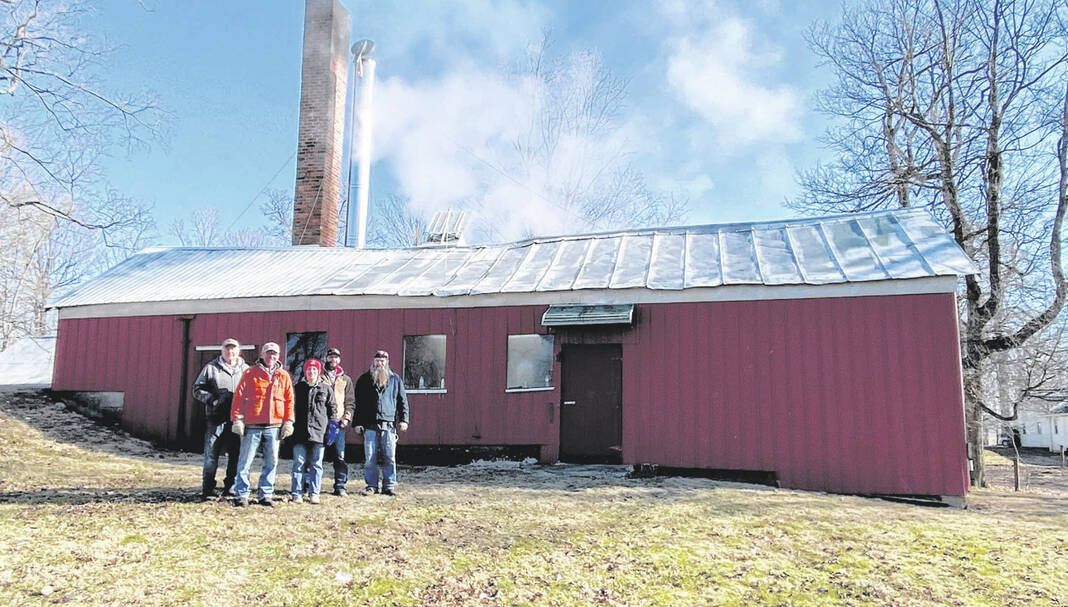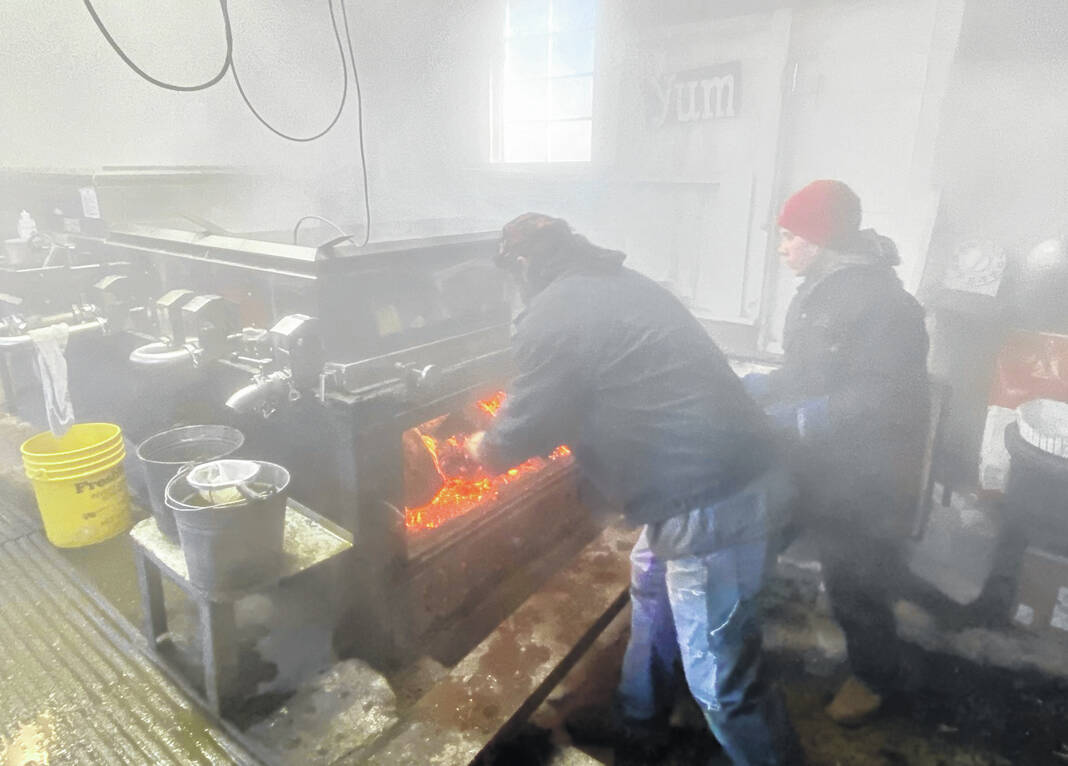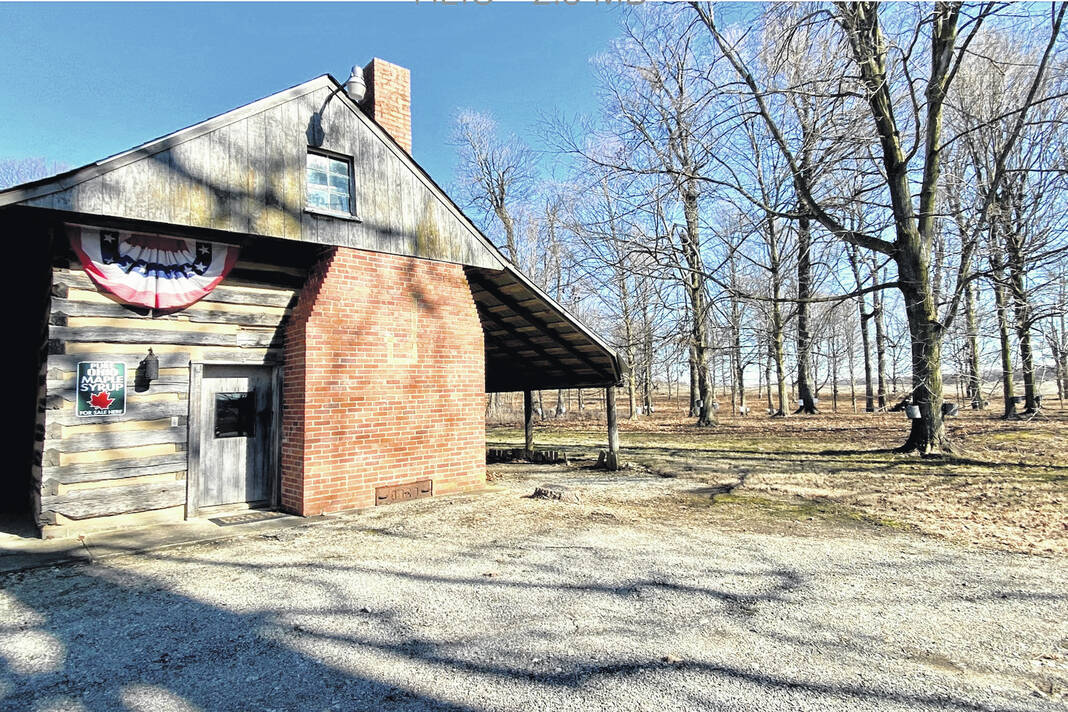
Pictured from left to right, Eric Johnson, Grant Johnson, Alfred Johnson, Galen Johnson and Neil Adams stand in front of the “sugar shed” while the steam from the boiling sap billows into a blue sky.

Neil Adams and Alfred Johnson stoke the furnace that boils the sap.
Photo by Alixandria Wells-Good

The Johnson family cabin, built in the 1800s, stands in front of the tapped trees of the sugar woods.
Photo by Alixandria Wells-Good
By Alixandria Wells-Good
Contributing writer
MINGO – Maple syrup season is upon us here in Champaign County.
At the Johnson Maple Syrup Farm, located near Mingo, the trees have been running and the family has been busy collecting sap from them to make sweet and delicious syrup for our tables.
Eric Johnson, along with two of his brothers, their children and their grandchildren, continue the family’s long history of working in the sugar woods, producing hand-collected local maple syrup using a combination of traditional and modern techniques.
Maple syrup is made from sap that is collected from sugar maple trees. All plants produce sap, however each plant’s sap is different depending on that plant. The sap from a sugar maple tree has a much higher sugar content than most other plants. A sugar maple tree uses the process of photosynthesis to convert sunlight and air taken in from the leaves and water taken in from the roots to produce sugar. T
he sugar is then stored in the tree’s trunk in the form of sap to prepare for winter. The beginning of syrup season is mostly dependent on weather. Sugarmakers look for warm days followed by freezing nights, which will get the sap flowing freely during the day, making this time ideal for sap collection.
The syrup season at the Johnson Maple Syrup Farm begins with the trees being tapped with 5/16 spiles, which are small metal pegs that are inserted into the tree approximately ¾ of an inch. When inserting the spile, it needs to go through the tree’s bark to the white wood beneath. It’s estimated that it can take the tree approximately 20 years to grow out beyond a tap. According to Eric, the farm typically gets 4 to 6 weeks of sap collection from a tap, and they tap anywhere between 650 to 700 trees with about 1,300 taps.
On the Johnson Maple Syrup Farm, all of the sap is collected into buckets that hang off of the spiles. On a collection day, a tractor hauling a 400-gallon collection tank is driven through the sugar woods. The buckets are hand collected by the Johnson family, friends and volunteers and emptied into the collection tank. The collection tank is then emptied into the “sap shed,” where there is a 4,000-gallon tank to hold the sugar water. From there, the sugar water is discharged into tubing underground that runs to the “sugar shed.”
The sap enters the sugar shed at about 2% sugar, and by the time it is bottled syrup is about 66% sugar. The sap goes through a boiling process that removes around 45-50 gallons of steam to each gallon of syrup. A roaring wood fire furnace, stoked by helpers like grandson Alfred Johnson and family friend Neil Adams, keeps the sap boiling through the whole process. From the boiling tanks the syrup is run through a 14-filter press before arriving at the bottling station. From the time the sap enters the sugar shed to the time it’s being bottled takes approximately three hours.
During the off-season, maintenance of the sugar woods includes mowing to make for easier tapping and collection during the season. Grant Johnson and his sons and grandsons spend time collecting fallen limbs and cutting firewood that will later feed the fire that boils the sap. There’s also buckets and spiles that need to be cleaned and equipment that is maintained in between seasons.
The Johnson family has a long history of syrup making. The original Johnsons came to the area in 1804, just one year after Ohio became a state. They settled at the farm in 1805. A few generations later, a cabin was built on the farm where Eric says his grandfather was born in 1884.
In 1982, the cabin was moved to where it sits today. Eric’s father re-mudded the cabin and put it back together, and the family held a Thanksgiving dedication in 1984, 100 years after his grandfather was born in the same cabin. Eric recalls his own children having sleep-overs with their cousins in the cabin where it sits now, and of course the kids would wake up to their grandma’s pancakes with maple syrup from their very own trees.
Today, the cabin acts as a sort of store front for the Johnson Maple Syrup Farm. There is also a table where information on the history of the farm and the family is available to look at.
Johnson Maple Syrup can be found at the farm, as well as in Urbana at Freshwater Farms and Mumford’s and at Jones Country Store in West Liberty. The family also sells at the Marysville Farm Market. The Johnson family enjoys visitors at the maple farm; they often host home-school groups, and in 2011 had a quilt tour.
Eric shared that the last few years the family has even hosted a pancake breakfast in March. While they don’t produce as much as other farms which use tubing for collection, the Johnson family is proud of the hard work that is put into their syrup, and the legacy that their trees stand for – a legacy of a family who works together and doesn’t shy away from the hard labors of sweet, sugary love.

